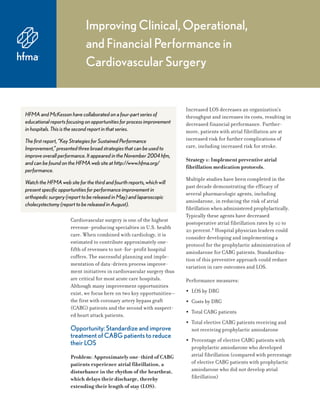
Improve CV Surgery Performance With CABG, AMI Process Changes
- 1. Improving Clinical, Operational, and Financial Performance in Cardiovascular Surgery Cardiovascular surgery is one of the highest revenue-producing specialties in U.S. health care. When combined with cardiology, it is estimated to contribute approximately one- fifth of revenues to not-for-profit hospital coffers. The successful planning and imple- mentation of data-driven process improve- ment initiatives in cardiovascular surgery thus are critical for most acute care hospitals. Although many improvement opportunities exist, we focus here on two key opportunities— the first with coronary artery bypass graft (CABG) patients and the second with suspect- ed heart attack patients. Opportunity: Standardize and improve treatment of CABG patients to reduce their LOS Problem: Approximately one-third of CABG patients experience atrial fibrillation, a disturbance in the rhythm of the heartbeat, which delays their discharge, thereby extending their length of stay (LOS). Increased LOS decreases an organization’s throughput and increases its costs, resulting in decreased financial performance. Further- more, patients with atrial fibrillation are at increased risk for further complications of care, including increased risk for stroke. Strategy 1: Implement preventive atrial fibrillation medication protocols. Multiple studies have been completed in the past decade demonstrating the efficacy of several pharmacologic agents, including amiodarone, in reducing the risk of atrial fibrillation when administered prophylactically. Typically these agents have decreased postoperative atrial fibrillation rates by 10 to 20 percent.1 Hospital physician leaders could consider developing and implementing a protocol for the prophylactic administration of amiodarone for CABG patients. Standardiza- tion of this preventive approach could reduce variation in care outcomes and LOS. Performance measures: • LOS by DRG • Costs by DRG • Total CABG patients • Total elective CABG patients receiving and not receiving prophylactic amiodarone • Percentage of elective CABG patients with prophylactic amiodarone who developed atrial fibrillation (compared with percentage of elective CABG patients with prophylactic amiodarone who did not develop atrial fibrillation) HFMA and McKesson have collaborated on a four-part series of educational reports focusing on opportunities for process improvement in hospitals. This is the second report in that series. The first report, “Key Strategies for Sustained Performance Improvement,” presented three broad strategies that can be used to improve overall performance. It appeared in the November 2004 hfm, and can be found on the HFMA web site at http://www.hfma.org/ performance. Watch the HFMA web site for the third and fourth reports, which will present specific opportunities for performance improvement in orthopedic surgery (report to be released in May) and laparoscopic cholecystectomy (report to be released in August).
- 2. Strategy 2: Ensure effective heart-rate stabilization and antithrombolytic medication therapy. Patients who are experiencing atrial fibrillation are at increased risk for stroke, as mentioned earlier. They require rate-control intravenous anticoagulant medications to stabilize their heart rates. A typical regimen begins with heparin administration, followed in later days by administration of warfarin. Clinicians manage this complex medical scenario to minimize risk of stroke. If medications are provided in the right sequence and duration, outcomes can be improved and LOS reduced. Performance measures: • CABG LOS • CABG variable direct costs • Percentage of total CABG patients with atrial fibrillation • LOS for CABG patients with atrial fibrillation • Time between CABG procedure and first evidence of atrial fibrillation, using rate- control medication administration as the proxy • Percentage of atrial fibrillation patients suf- fering a stroke postoperatively Opportunity: Improve the diagnosis of patients presenting with suspected acute myocardial infarction to improve their clinical outcomes and reduce their LOS Problem: Rapid diagnosis of acute myocardial infarction (AMI) is critical to optimal patient outcomes. Heart attacks are a high-volume health prob- lem worldwide, and nearly 5 million Americans suffer a heart attack each year. Individuals presenting to EDs with acute chest pain and suspected AMI represent one of the most pressing diagnosis and care challenges faced by acute care facilities. Every minute that passes without medical treatment after a heart attack reduces patients’ survival rates. The costs associated with diagnostic workups are significant, yet at least one-third of pre- senting patients have not actually experienced an AMI. Unfortunately, 5 to 8 percent of patients discharged from the ED are found to have suffered an AMI.2 Failure to diagnose and treat AMI patients in the ED results in large malpractice settlements each year. Strategy: Improve timeliness and accuracy of diagnostic workup. If a heart attack is suspected, the ED physician will usually order tests to confirm or rule out a heart attack. Tests may include an electrocar- diogram, echocardiogram, cardiac enzyme lab- oratory studies, stress test, or coronary catheterization. Timing of diagnostic tests and their accurate interpretation by ED staff are critical. Standardization of the ordering of tests through use of clinical pathways can reduce costs per stay (for example, decrease wastage of nuclear cardiology and cardiac cath laboratory materials) and LOS, while improv- ing patient satisfaction. Performance measures: • Time from presentation in the ED and start of cath laboratory procedure • Mortality • LOS • Timing, utilization, and outcomes of coronary catheterization 1. Institute for Clinical Systems Improvement, “Atrial fibrillation,” Bloomington, Minn: Institute for Clinical Systems Improvement, 2003. 2. McCarthy, B.D., Beshansky, J.R., D’Agostino, R.B., et al. “Missed Diagnosis of Acute Myocardial Infarction in the Emergency Department,” Annals of Emergency Medicine, 1993. 22:579-582.mington, Minn: Institute for Clinical Systems Improvement, 2003. McKesson's Resource Management solutions specifically focus on uncovering opportunities to improve operational efficiency, clinical effectiveness and fiscal viability. We offer an outcomes-based approach to solving your business performance objectives. Our comprehensive solution set includes advanced operational, financial and clinical analytic tools, and specialized departmental software and process improvement experts committed to achieving your organizations' business initiatives. To learn more about McKesson, please contact us at 800.861.9801 or http://infosolutions.mckesson.com.